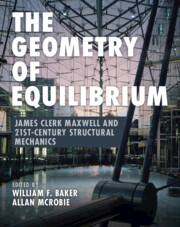
-
Select format
-
- Publisher:
- Cambridge University Press
- Publication date:
- May 2025
- May 2025
- ISBN:
- 9781009397643
- 9781009397612
- Dimensions:
- (254 x 203 mm)
- Weight & Pages:
- 0.89kg, 324 Pages
- Dimensions:
- Weight & Pages:
You may already have access via personal or institutional login
Book description
James Clerk Maxwell is one of the giants of scientific thought, and whilst his groundbreaking contributions to electromagnetism and statistical physics are well known, his profound insights into the theory of structures are appreciated less widely. Maxwell's approach was deeply geometrical, and this richly illustrated book reveals his astute perception of the remarkable dualities that exist between the form of a structure and the forces it can carry, with understandings that will surprise contemporary readers. Early chapters introduce the background in which Maxwell was working, followed by contributions by leading researchers describing the latest applications of these ideas. Subsequent chapters introduce the many subtopics that this work embraces. The book ends with Maxwell's original papers on structural mechanics, each annotated to highlight and explain the ideas therein. This is a wonderful resource for mathematicians, scientists, engineers, and designers to enter this rich and underexplored aspect of the genius of Maxwell.
Reviews
‘Remarkable homage to the amazing creativity of James Clerk Maxwell. Three portraits accompanied Einstein from Germany into Princeton: Newton, Faraday, and Maxwell. But when asked if he stood on the shoulders of Newton, he replied ‘No, on the shoulders of Maxwell’. Much has been written about Maxwell’s creativity rooted in physical analogy. This is an erudite example of consequences of Maxwell’s geometric thinking.’
Julio M. Ottino - R.R. McCormick Institute and Walter P. Murphy Professor, Engineering and Applied Science, Northwestern University and author of The Nexus: The New Convergence or Art, Technology, and Science
‘Engineers are largely ignorant of Maxwell’s geometric methods applied to structural theory, and geometers are equally unaware of the application of their discipline to the design of structures. This book is an exciting attempt to remedy this and will interest engineers and mathematicians for its elegance and practical application.’
Chris J. K. Williams - Chalmers University of Technology
‘This rediscovery of James Clerk Maxwell by renowned expert opens a world of graphic statics, shell design and lightweight building for structural engineers. Maxwell’s achievements turn out to be very modern because they help minimise the use of resources and, therefore, can lead to truly sustainable structures. What makes this book special is that the original papers of Maxwell are included and made readable through detailed explanations. A great effort by the authors for the benefit of the reader.’
Mike Schlaich - Technische Universität Berlin
Contents
Metrics
Altmetric attention score
Full text views
Full text views help Loading metrics...
Loading metrics...
* Views captured on Cambridge Core between #date#. This data will be updated every 24 hours.
Usage data cannot currently be displayed.
Accessibility standard: Unknown
Why this information is here
This section outlines the accessibility features of this content - including support for screen readers, full keyboard navigation and high-contrast display options. This may not be relevant for you.
Accessibility Information
Accessibility compliance for the PDF of this book is currently unknown and may be updated in the future.


